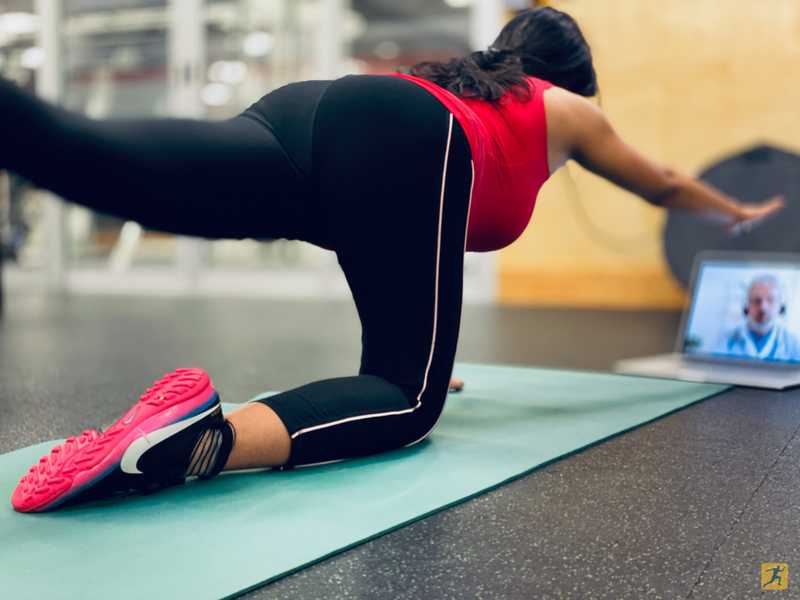If you are experiencing hip or groin pain, you may be wondering what the best treatment option is. Hip and groin pain can occur at the same time or independently. They can be caused by many different things, including local or global lower body impairments. That’s why it’s important to see a healthcare provider to get to an accurate diagnosis and understand what is causing your pain in the first place.
Physical therapy can help to reduce hip and groin pain and improve your mobility. In this guide, we will discuss the symptoms, causes, diagnosis, and treatment options for hip and groin pain. This information will help you to make the best decision about how to treat your hip or groin pain.
Table of Contents
- Understanding Hip and Groin Pain
- Symptoms of Hip Dysfunction and Pain
- What Are the Most Common Causes of Pain?
- How to Diagnose Hip Dysfunction
- Treatment Options for Hip and Groin Pain
- What If Conservative Care Doesn’t Work?
- How to Prevent Hip and Groin Pain
- Is It Time to Get Treatment for Your Hip?
Understanding Hip and Groin Pain
Aside from the shoulder, the hip is one of the most mobile joints in the body. Plus, it can functionally bear all of the weight of the trunk and upper body. Healthy and pain-free hip joints allow us to do so many things: chase after our dogs or children, squat down to tie your shoes, stand comfortably and chat with a dear friend or neighbor, and dance, walk and run with purpose and grace.
When there is an onset of pain in the hip or groin region, this can put a major damper on your daily activities and the ability to participate in life the way you'd like.
Anatomy of the Hips
Before we discuss hip and groin pain in more detail, let’s review some hip anatomy.1 The hip is a "ball-and-socket" joint. The top of the thighbone (femur) forms a round ball that fits snugly into the hip socket (acetabulum). The hip socket is formed by the pelvis.
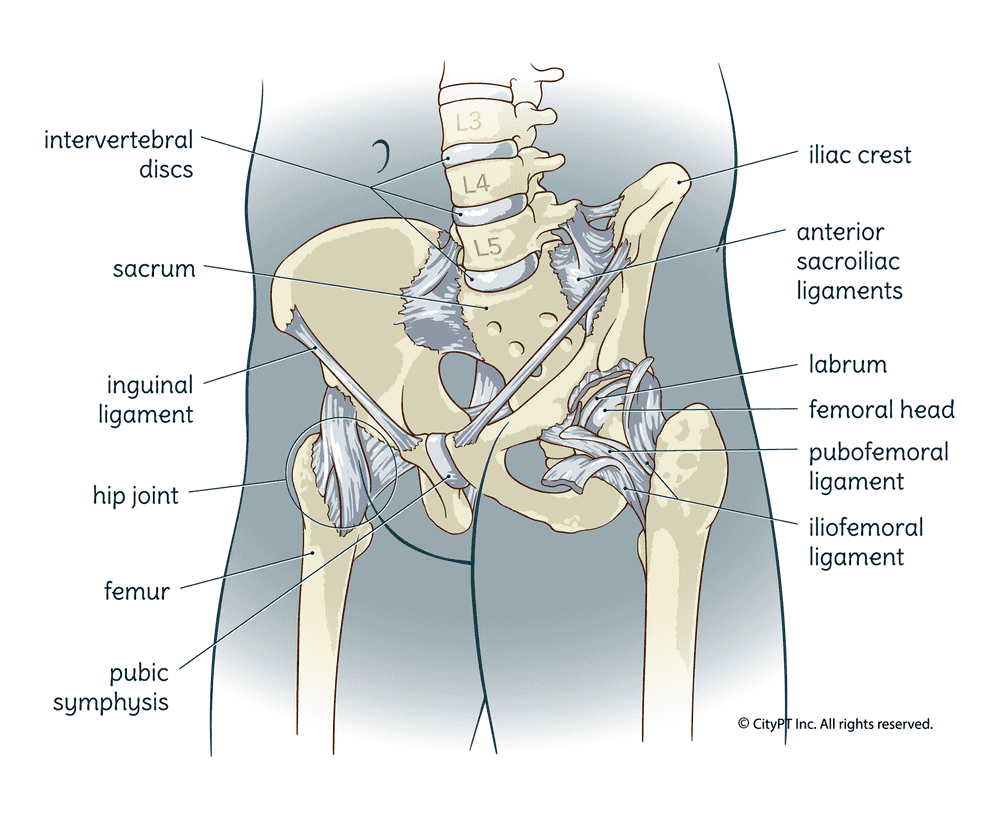
Ligaments and muscles around the hip joint provide stability, while cartilage covers the surface of the bones to help with smooth movement. An additional layer of cartilage, called the labrum, lines the rim of the hip to provide more stability by deepening the socket. There is also a layer of fluid between the articular cartilage that lubricates and nourishes the joint. This is called synovial fluid.
The hip joint is buried in many layers of muscle and local connective tissue. There are small muscles close to the joint that control rotation. Plus, there are larger muscle groups like the gluts, adductors (inner thigh), and hip flexors. Together, these muscles work to provide power, stability, and endurance to this important shock-absorbing joint.
Symptoms of Hip Dysfunction and Pain
There can be many different symptoms associated with hip and groin pain. The pain may be sharp or dull, constant or intermittent. It may also radiate to other areas of the body, such as the knee, thigh, low back, or buttocks.
Additional symptoms include:
- Stiffness in the hip joint
- Limited hip range of motion
- Muscle weakness
- Instability in the hip joint
- Clicking or popping sound when moving the hip
- Feeling like the hip is "giving out" or "locking up"
- Swelling or redness around the joint
What Are the Most Common Causes of Pain?
If you're in pain, you've probably found yourself concerned and wondering why your hip hurts. Below are some of the possibilities. It's important to note that there is a lot of overlap between hip and groin pain. A physical therapist can help you determine the true cause of your pain.
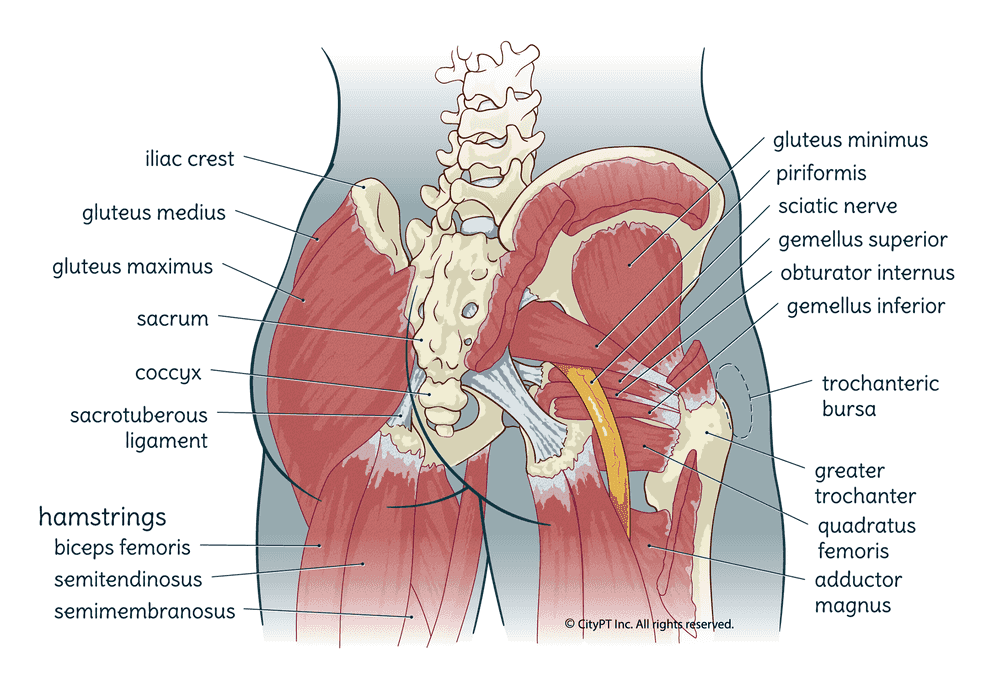
Acute Causes (Sudden) of Hip or Groin Pain
Certain conditions may cause sudden onset of pain, sometimes debilitating, in the hip or groin. Below are some of those acute causes, most commonly associated with injury.
It should be noted that for kids, there are a number of causes of hip, thigh, and groin pain not included below (e.g. growth plate injuries, Perthes disease, slipped capital femoral epiphysis). All kids complaining of hip, groin, or thigh pain, should be evaluated by a physical therapist or other specialized and qualified healthcare provider.
Hip or Pelvis Fracture
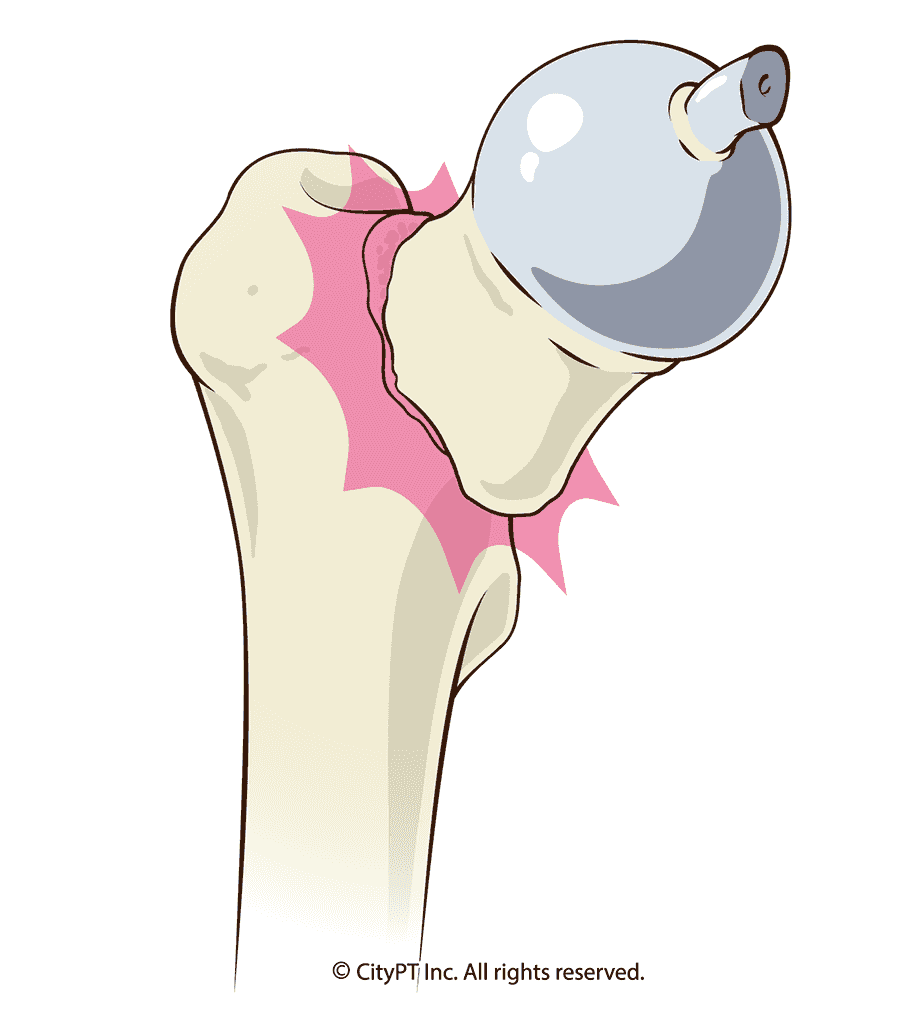
A hip fracture is a break in the upper part of the thighbone or pelvis (socket). It can happen after a fall or other type of accident. Hip fractures are most common in older adults with osteoporosis, but they can occur at any age. Unfortunately, hip fractures, particularly in adults over 65, are associated with an increased risk of overall mortality and put a significant financial burden on the medical system.2 With 1 in 3 women experiencing hip fractures in their lifetime, this is a serious cause of pain that needs to be prevented and managed effectively.
Direct Impact
With a fall, impact, or accident, even if there is no fracture present, there will likely be bruising and swelling in the area that elicits hip or groin pain.
Muscle Strain
The hip is surrounded by many muscles, with many interconnected to the low back, pelvic floor, and knee. When these muscles are strained or pulled, it can cause pain in the hip and groin region. This is seen in athletes who participate in high-impact sports or anyone attempting a new activity. It can also be caused by chronic repetitive use. Muscle groups most commonly affected include the hip flexors, hamstrings, quadriceps, and adductors (inner thigh/groin).3
Post-Surgical Pain
After hip replacement surgery or laparoscopic surgery, it is common to experience hip and groin pain. This is usually due to the incision site, local swelling, and surrounding muscles and tissues that were affected during the surgery.
Labral Tear
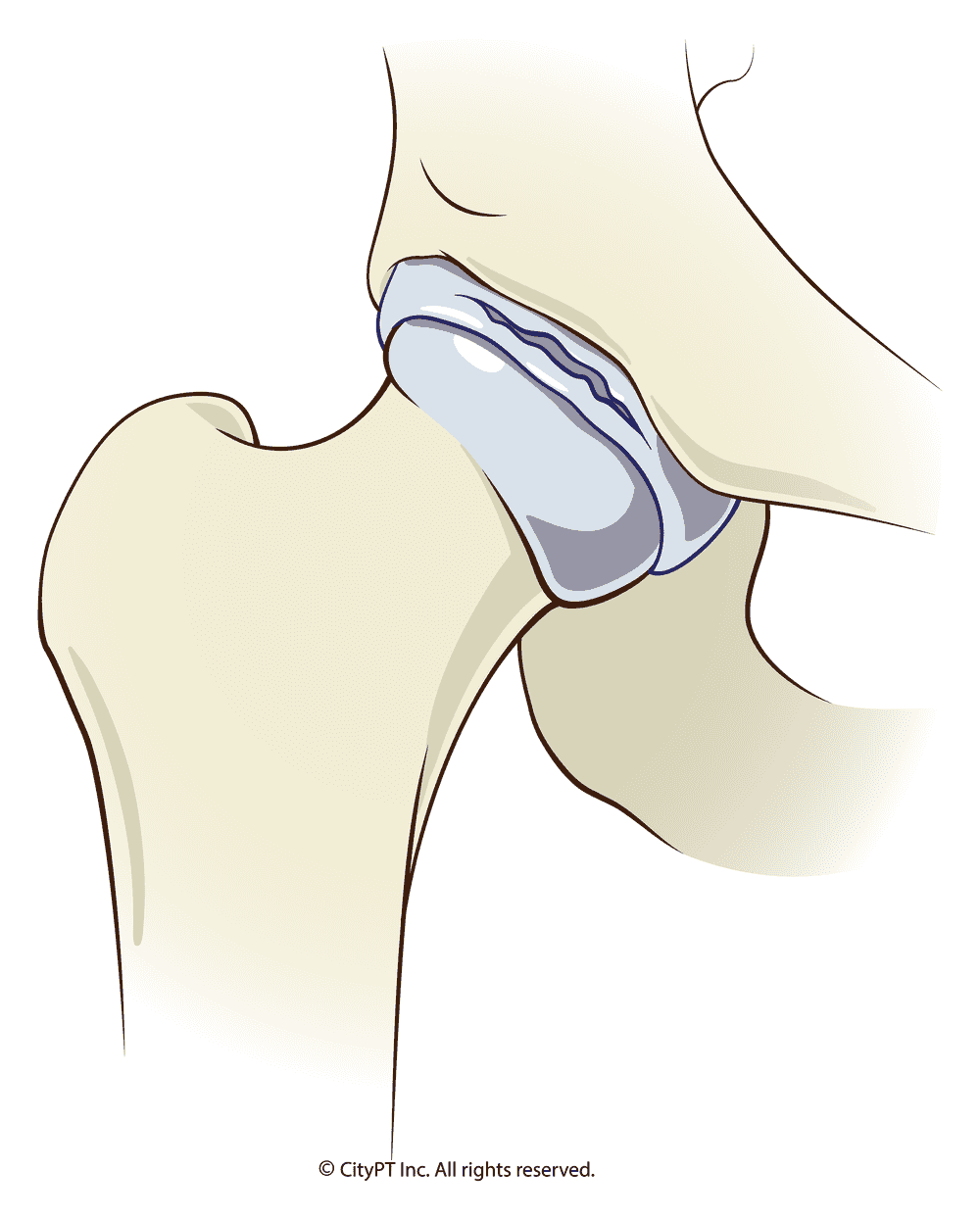
The hip joint is surrounded by a ring of cartilage (labrum) that helps to stabilize the joint. A tear in this cartilage can cause hip and groin pain. This is often seen in athletes or anyone who participates in activities that involve a lot of twisting and turning (such as soccer, golf, or hockey). It can also occur from hip wear over time and is a risk factor for developing osteoarthritis.4
Hip Dislocation
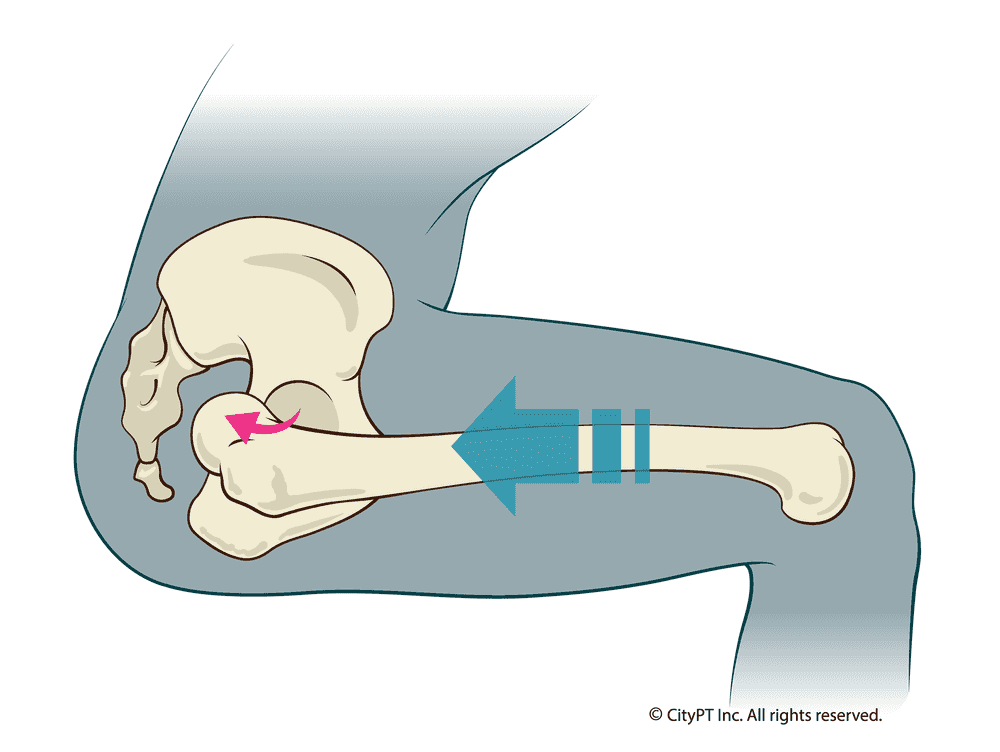
When the hip joint is forced out of its socket, this is called hip dislocation. It's a very serious injury that requires immediate medical attention. It is relatively uncommon and is most often associated with high-impact sports, a car accident, or following hip replacement surgery.
Overuse and Chronic Causes of Hip or Groin Pain
Pain can develop over time in the hip and groin region. In these cases, overuse or not attending to small pain, can turn into a chronic pain.
Tendinitis
Tendinitis is the inflammation of a tendon, the rope-like structures that attach muscles to bones. It's often caused by repetitive motions or overuse of the hip joint. Common areas include the iliopsoas, gluteals, and hamstring tendons. If not addressed, tendinitis can lead to tendinosis.
Tendinosis
Tendinosis is defined as degenerative tissue changes that often result from the overuse of tendons that aren't given adequate time for recovery. It's similar to tendinitis but with the addition of microscopic tears in the tendon tissue that leads to thick, fibrotic, and dysfunctional local tissue.
Snapping Hip Syndrome
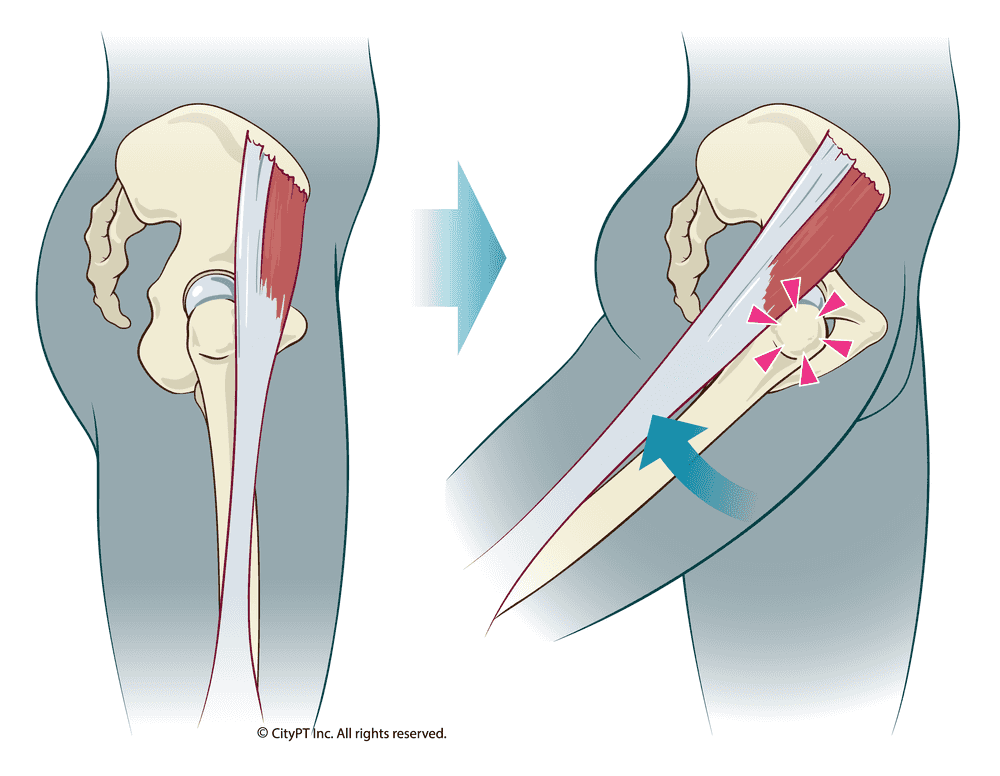
Snapping hip syndrome, also known as coxa saltans, is a condition in which you feel a snapping sensation or "pop" in your hip when you walk, run, get up from a chair, or swing your leg around. This snapping sensation is caused by the movement of tendons or muscles over bony structures in the hip, either affecting the lateral (outside) or medial (inside) structures. Snapping hip alone is not worrisome. It is primarily a concern if it leads to the onset of hip pain, warranting conservative treatment.5
Bursitis
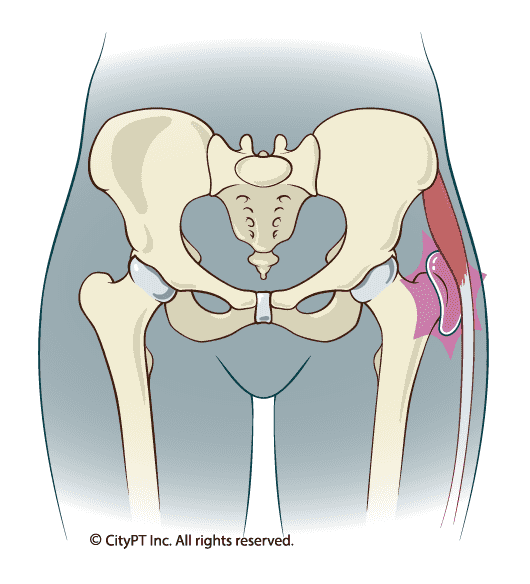
Bursitis is the inflammation of a bursa. Bursae are small, fluid-filled sacs that act as lubricating cushions between bones and tissues (such as muscles, tendons, or skin) around joints. There are many bursae in the hip joint and when they become inflamed, it can cause hip pain. The most common area in the hip is over the greater trochanter (the bony bump of the femur on the side of the hip).6 Another common area for bursitis is over the ischial tuberosity and it causes sit bone pain.
Osteoarthritis
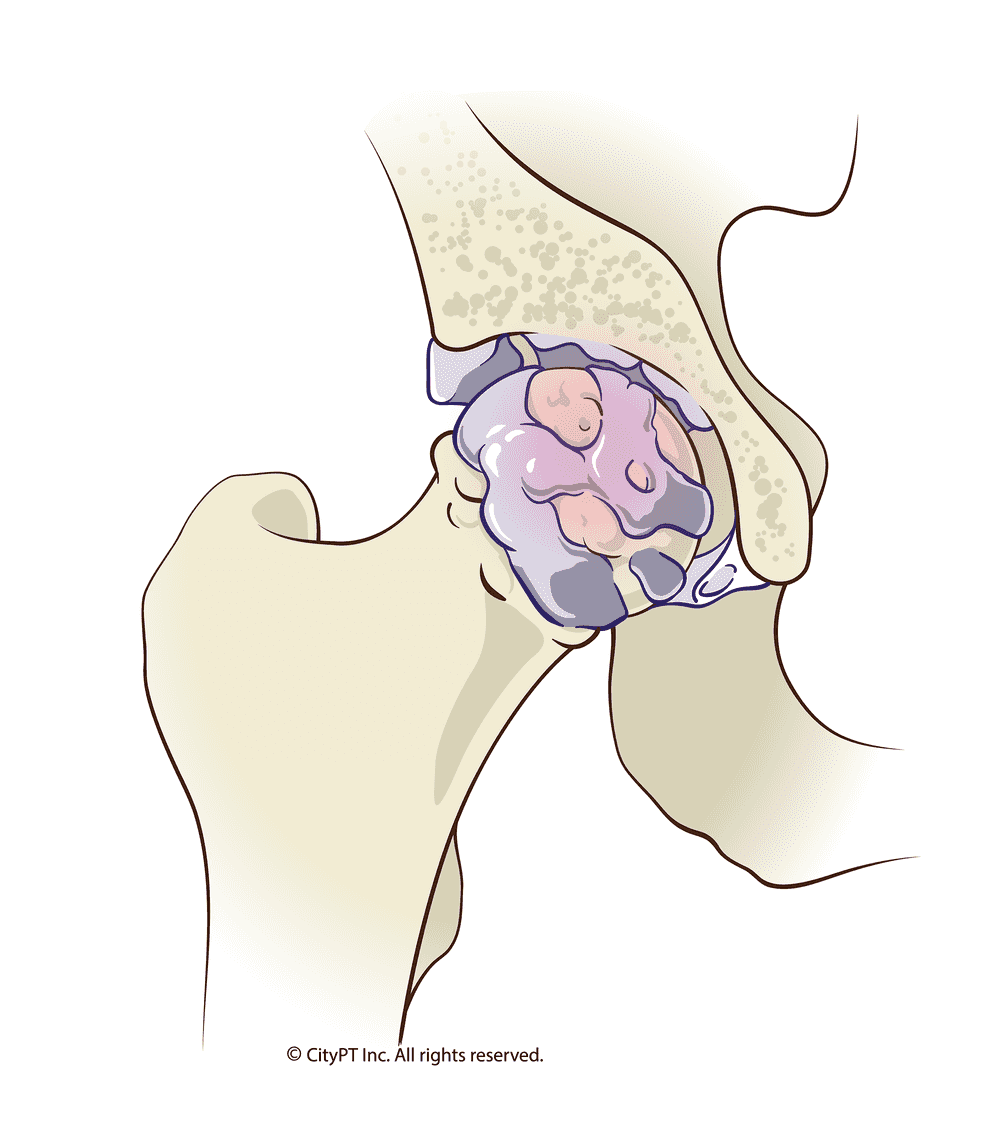
Osteoarthritis (OA) is a degenerative joint disease that occurs when the cartilage (the cushioning between bones) breaks down. This can happen due to age, injury, or overuse of the hip joint. OA can also be caused by congenital changes in the hip joint, such as hip dysplasia. OA often leads to pain and stiffness in the hip.
Hip Impingement (Femoroacetabular Impingement)
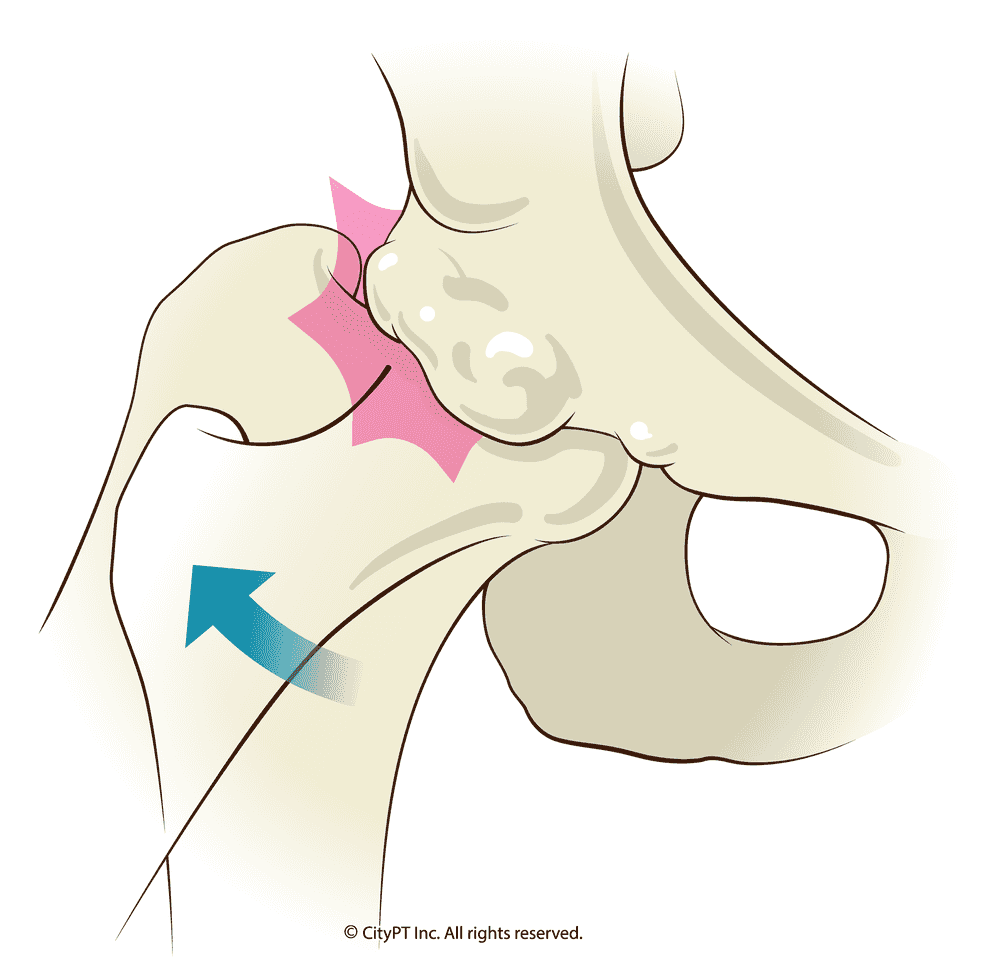
Femoroacetabular impingement (hip impingement) is a condition in which the hip joint is not able to move as freely as it should. This can be due to bony growths, hip dislocation, a labral tear, or hip fracture. Acetabular impingement often leads to pain and loss of range of motion in the hip.
Athletica Pubalgia (Sports Hernia)
Athletica pubalgia, also known as a sports hernia, is a condition in which the muscles and tendons of the hip or groin area are injured. This can be due to overuse or repetitive motions. Athletes who participate in high-impact sports such as football, hockey, or running are at a higher risk for developing this condition.
SI Joint Pain
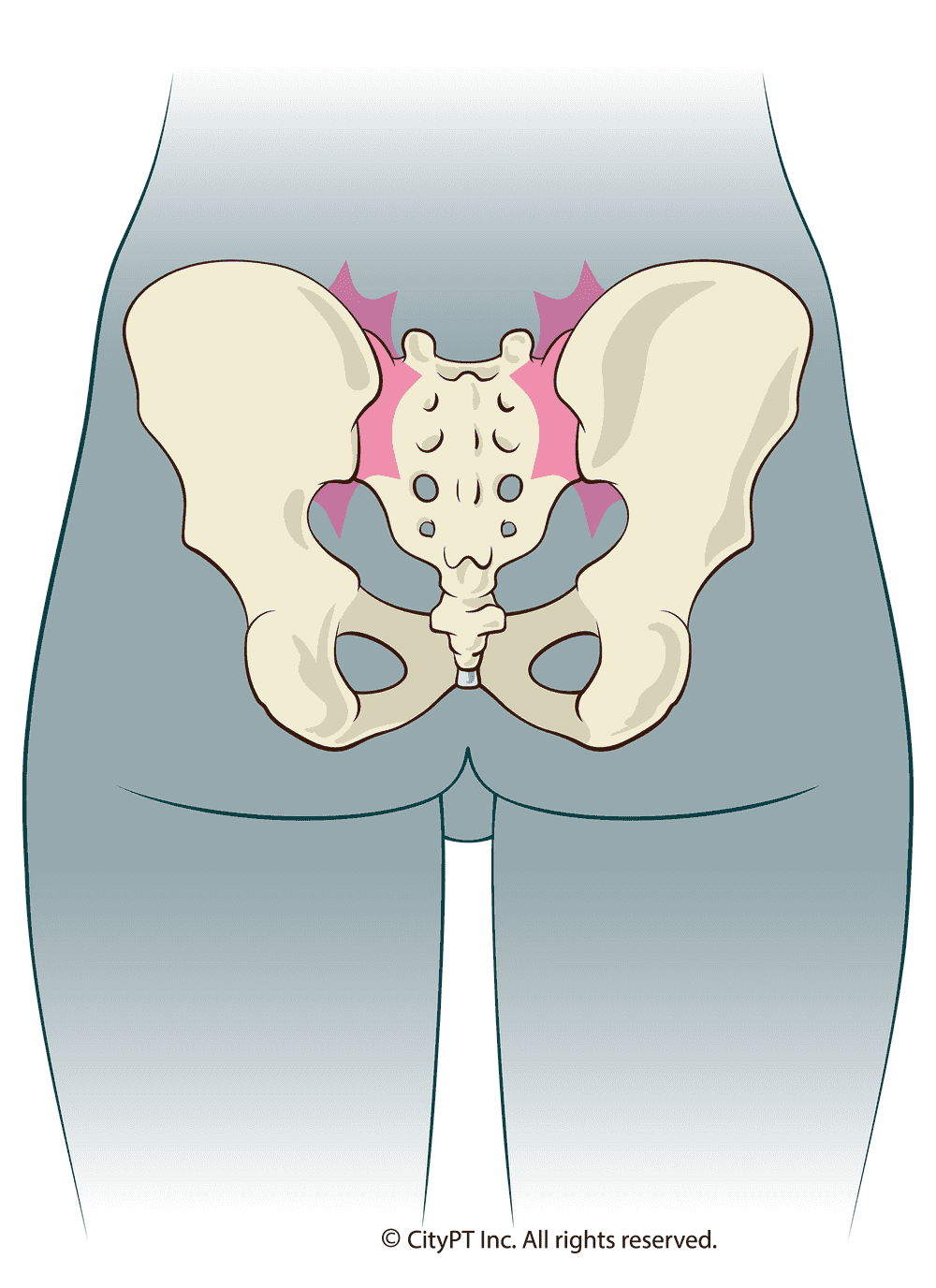
SI joint pain is a condition in which the sacroiliac joints (the joints in the back between the pelvis and spine where many of us have dimples) become inflamed. This can be due to injury, arthritis, or pregnancy.
Pelvic Floor Dysfunction
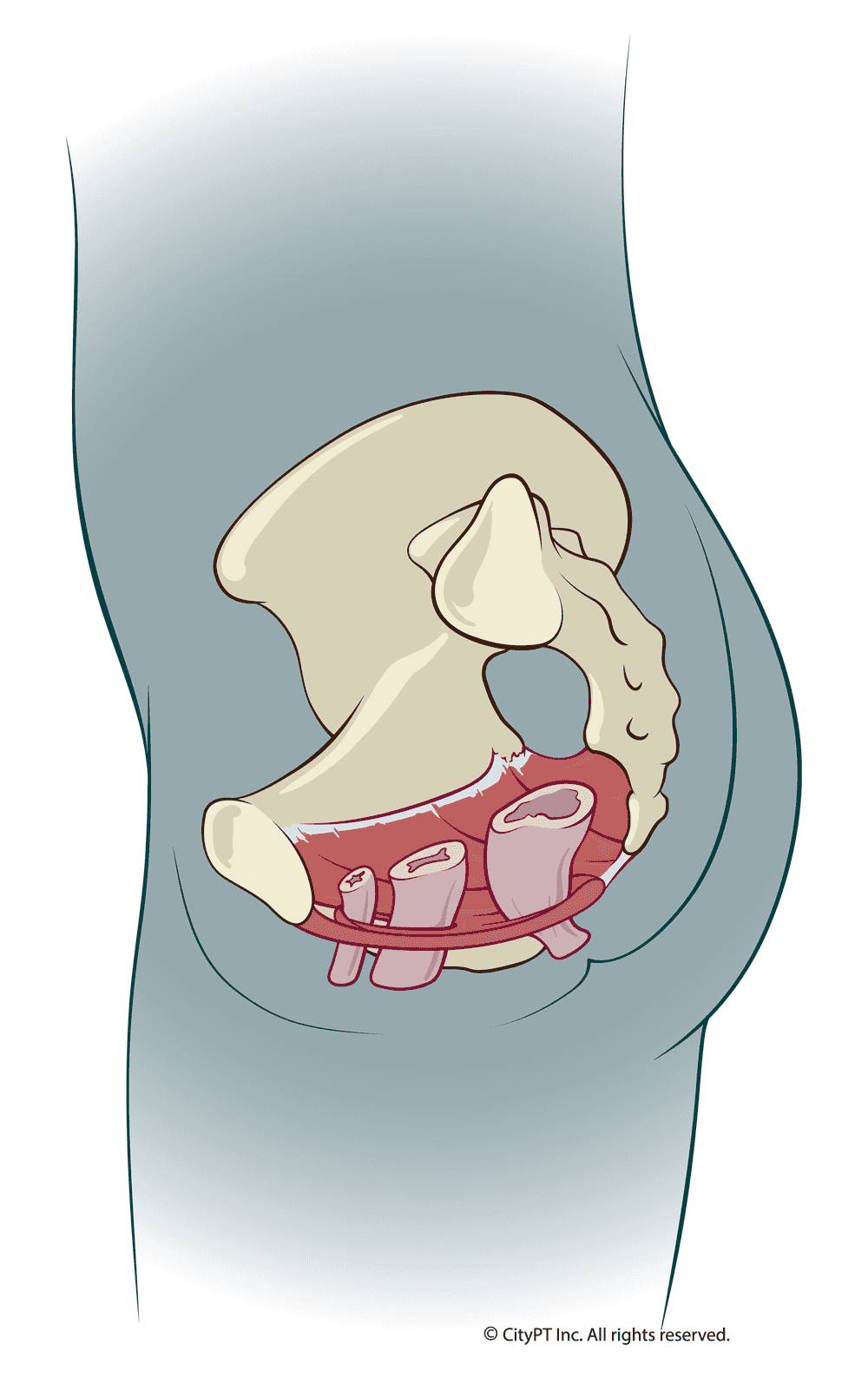
Pelvic floor dysfunction is a condition in which the muscles of the pelvic floor (the muscles that support the organs in the pelvis) are weak, tight, or injured. This can lead to pain in the hip or groin area. Pelvic floor dysfunction is often seen in women who have had multiple pregnancies or who have gone through menopause. However, it can affect women (and men too) of all ages and walks of life.
Hip Dysplasia
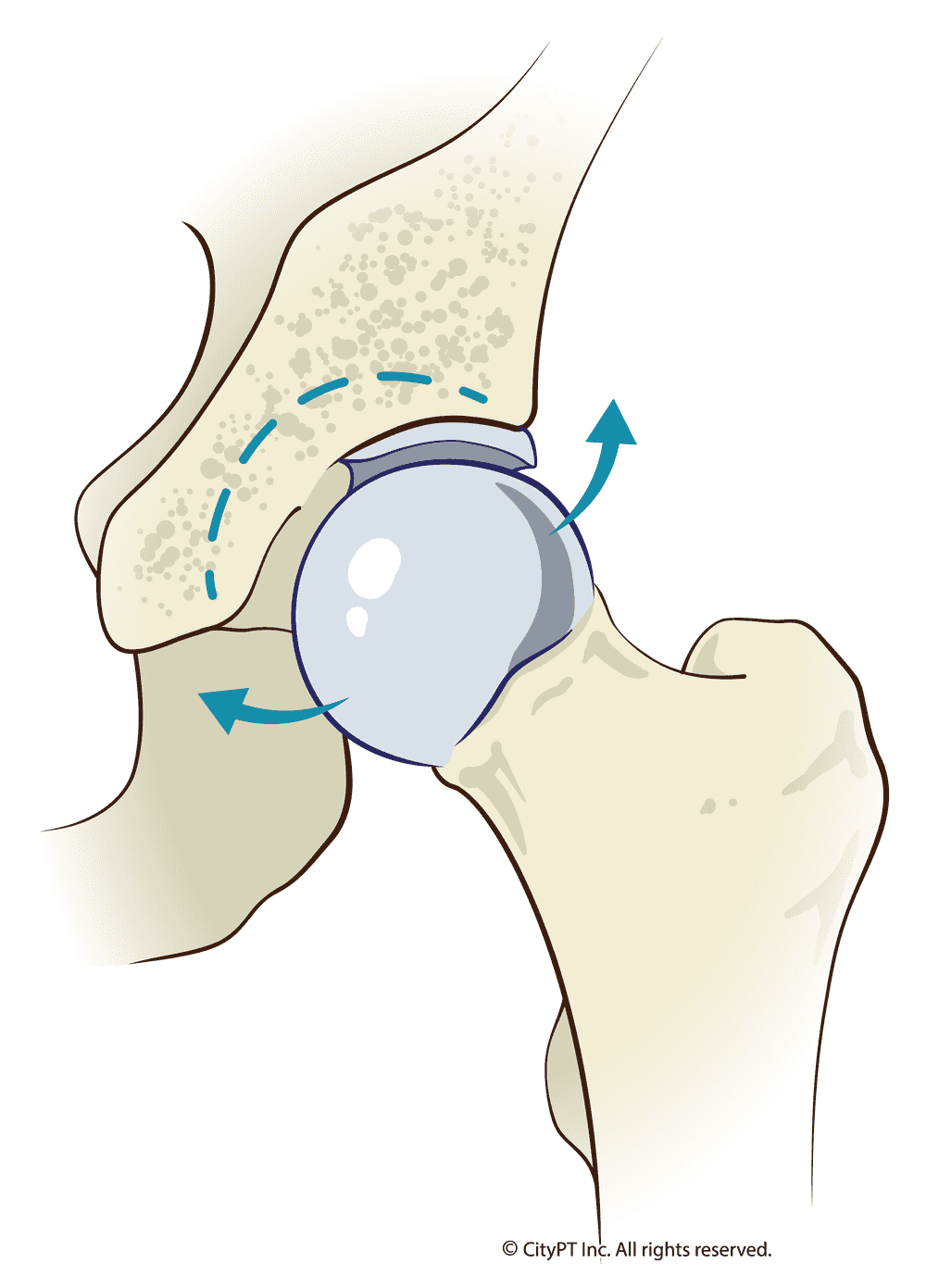
Hip dysplasia is when you are born with a shallow socket in this ball and socket joint. Sometimes this is diagnosed at birth but a large number of cases are not discovered until hip pain develops in adolescence or early adulthood. While this is a common cause of labral tears and early onset arthritis, patients with hip dysplasia may have intermittent (off an on) symptoms earlier in life due to lack of stability that is usually provided by a deeper hip socket.7
Other Causes
Other causes of pain include:
- Avascular necrosis (lost circulation to tissues of the hip joint)
- Endometriosis
- Ovarian cyst
- Infection (of local bone or the joint itself)
- Tumor
- Inflammatory arthritis such as rheumatoid arthritis or psoriatic arthritis
- Hernia (inguinal hernia)
- Obturator muscle
How to Diagnose Hip Dysfunction
If you are experiencing hip and/or groin pain, the first step is to see your doctor or a physical therapist. They will ask about your symptoms, medical history, and activity level. They will also perform a physical examination. This may include tests such as range of motion, muscle strength, and reflexes.
Remember: You do not need a referral to see a physical therapist! In fact, you can book now to get answers to your hip pain as soon as possible.
PT Evaluation
When you see a physical therapist, they will be able to assess your hip and groin region more thoroughly. At a patient-focused clinic, you can expect to spend up to 60 minutes with your therapist, as compared to an average of 13 to 24 minutes with a primary care provider.8 This will help to determine the true underlying cause of your pain and develop a sustainable treatment plan, rather than just masking symptoms with short-term pain relief.
A high-quality physical therapist will also:
- Assess your posture and mechanics — during sleep, sitting, driving, working, cooking, gaming, etc.
- Discuss your lifestyle, such as stress management, mental health, sleep, and diet
- Look for any muscle imbalances
- Test your range of motion
- Perform special joint tests to look at the integrity of local tissues
- Perform strength tests
- Evaluate your walking and running pattern, and any other movements you participate in regularly (sports, hobbies, etc.)
This kind of depth is what truly makes the difference in creating a personalized program that addresses your deficits. No guessing or one size fits all approach.
Imaging
If needed, imaging tests, such as x-rays, MRIs, or CT scans, may also be ordered. These tests can help to rule out certain causes of pain and identify the source of your hip and groin pain. While it can help direct treatment, it is not always necessary with the use of the right evaluation tools as discussed above.
Treatment Options for Hip and Groin Pain
The good news is that hip and groin pain can be treated conservatively. Treatment will vary depending on the underlying cause of your pain. Common treatment options include:
- Rest (acutely)
- Ice/heat (acutely)
- Home exercises
- Physical therapy
- Surgery (in some cases)
What to Expect with Physical Therapy Treatment
Of all the options listed above, this is the only treatment option that provides long-term strategies for hip pain management. Treatments you can expect from a physical therapist include:
-
Education: The most important treatment of all. You will learn about your hip pain and gain a deep understanding of what's causing it. Your physical therapist should be able to explain the cause of your pain and how it can be treated. This will help you effectively manage your pain. Plus, they can provide you with tons of useful information related to posture, mechanics, expectations, and more.
-
Manual therapy: This hands-on approach may include joint mobilizations or manipulations, soft tissue massage, or trigger point dry needling. This can help to decrease pain, improve range of motion, and reduce inflammation. These techniques can be utilized, as needed, for short-term pain relief to be able to tolerate more active forms of treatment.
-
Activity modification: This may include changes in your daily activities, such as avoiding certain positions or movements that aggravate your hip pain. Your PT care provider can also provide you with a list of activities to avoid or modify during your recovery.
-
Ergonomic assessment and training: If your hip pain is due to repetitive stress or specific daily activities, your therapist can assess how your posture when working, sitting, standing, and lying down. They can then help you make any necessary changes to help prevent your hip pain from returning.
-
Modalities: This may include the use of electrical stimulation, ultrasound, or other modalities to help decrease hip pain. These are short-term treatments that can aid in the tolerance of exercise but should not be the primary focus of recovery.
-
Lifestyle: This is an important part of hip pain management and will be addressed throughout your treatment. Your therapist can provide you with basic information (or refer you to a specialist) on nutrition, weight loss/management, smoking cessation, stress management, and more.
-
Exercise prescription: This will be specific to your hip pain and will vary depending on the cause of your pain. Exercises typically include stretching, strengthening, balance, and agility exercises. The goal of the exercises is to improve overall hip joint function and to prevent hip pain from returning. You will begin these with your physical therapist- then transition to a home program over time.
Exercises to Try at Home
If hip pain is preventing you from being as active as you'd like, it’s important to start slowly when trying new exercises. In fact, doing the wrong exercises can lead to more pain and aggravation. Thus, you might consider skipping the DIY exercise completely and scheduling your first PT appointment as soon as possible to save yourself time, money, and frustration.
The following exercises can be tried at home to help improve hip joint function and reduce hip pain:
Hip Stretches
These basic stretches can address commonly stiff muscles around the hip joint. Hold each stretch for 60 seconds or more, for 2 to 3 sets per day as needed. Make sure to keep the stretch relatively pain-free.
- Standing hip flexor stretch: Also known as a runner's stretch, start by standing in a lunge position. Focus on keeping the spine neutral (no arching of the low back) so that you can feel a deep stretch in the leg that is behind you.
- Seated figure 4 stretch: First, sit down in a chair. Cross your right ankle over your left knee and allow your right knee to fall open. You should feel a deep stretch in the hip and buttocks of your crossed leg. Don't forget to switch!
- Standing IT band stretch: Start with your feet hip-width apart. Cross your right leg over in front of your left and lean to the right, keeping both feet flat on the ground. You should feel a stretch along the outside of your crossed left leg.
- Supine hamstring stretch: Lie on your back with both legs straight. Bring your right leg up, keeping the leg straight as you pull it toward your chest. You should feel a stretch along the back of your right thigh.
Hip Strengthening
These basic strengthening exercises can boost circulation to local hip tissues. Complete each exercise for 10 to 15 repetitions for 2 to 3 sets as needed.
- Side-lying hip abduction: Lie on your left side, with the right leg straight and your left leg bent to stabilize. Slowly raise your straight right leg as high as you can comfortably. Keep the hips stacked and abs activated to prevent wobbling. Switch and repeat.
- Hip bridge: Lie on your back with feet flat and shoulder-width apart, knees bent to 90 degrees. Push through your heels to lift your butt off the ground.
- Clamshells: Start by lying on your right side with both legs bent to 90 degrees (hips and knees) and feet together. Slowly lift your top knee while keeping your feet touching and heels aligned. Don't let your pelvis roll backward. Switch and repeat.
- Ball squeezes: Sit on a chair or stability ball with the feet hip-width apart and flat on the floor. Place a small ball or pillow folded in half between your legs. Squeeze and hold for 5 to 10 seconds.
Functional Moves
Most importantly, your exercises should be helping you restore or maintain optimal hip function that you need for daily activities. These exercises help challenge your hip coordination and strength in a way that has decent carry over to your daily routine. Try each move for 10 to 15 repetitions and for 2 to 3 sets.
- Single leg balance: Start by standing on your left leg with the knee slightly bent. Hold for 30 seconds, then switch sides. Focus on keeping the hips levels (use a mirror for feedback if needed).
- Squats: Start with the feet hip-width apart. Send your hips back as if you are about to sit in a chair, keeping the chest up, knees behind the toes, and weight evenly distributed in your feet. Then, push back up to standing and repeat.
- Alternating lunges: Start with your feet hip-width apart and take a large step forward with the right leg, keeping the knee above the ankle. Bend the back left knee, touching the ground gently if possible. Return to standing by pushing off of your right foot and bringing your feet back together. Alternate sides.
- Band walks (sideways, forward, backward): Place a looped resistance band above your ankles. Start with the feet hip-width apart and take small steps to the right, keeping tension on the band throughout. You should feel resistance in your legs and gluts as you move. Return to the start position by taking small steps backward or forward, depending on which direction you began traveling in.
What If Conservative Care Doesn’t Work?
If hip pain persists despite conservative care, other options can be considered. These include:
- Injections
- Surgery
Injections can be used to help manage hip pain by delivering medication directly to the site of pain. Common injections used to treat hip pain include corticosteroid injections and viscosupplementation injections. Surgery is typically only recommended as a last resort after all other conservative treatment options have failed. Hip surgery can be performed to repair or replace the hip joint.
If these more invasive options are utilized, conservative post-procedure care is still recommended to optimize your long-term outcomes and prevent re-aggravation, which is common if the underlying cause is not well understood.
How to Prevent Hip and Groin Pain
While hip and groin pain can't always be prevented, there are steps you can take to prevent unnecessary pain. These include:
- Wearing proper footwear: Choose shoes that support the foot and lower body to promote ideal gait (walking) mechanics. Shoes chosen for aesthetics or price can put a strain on the lower body and hips due to altered mechanics.9
- Warming up before physical activity: Before starting a workout, warm up your muscles and joints with active movement.
- Sleep with pillows: Pillows can be used to align your hips at night.
- Stay active: This will help you with ideal weight management, provide circulatory benefits, and keep the hip and core muscles strong.
- Reduce joint impact: With proper mechanics and strength, particularly if you participate in activities like running or jumping, you can protect your joints and reduce injury.
- Make healthy lifestyle choices to boost your body's healing potential: Eat a nutrient-dense diet, get enough sleep, and practice good stress management.
Is It Time to Get Treatment for Your Hip?
If hip pain is impacting your quality of life and you've been struggling to find relief, it might be time to seek professional help. Or if you'd like to take proactive action rather than waiting until you're in pain or miserable, it's never too soon to seek treatment.
A physical therapist can assess your hip and groin and create a custom treatment plan to help get you back to your best. Book an appointment right now with an experienced CityPT clinician.
This guide is intended for informational purposes only. We are not providing legal or medical advice and this guide does not create a provider-patient relationship. Do not rely upon this guide (or any guide) for medical information. Always seek the help of a qualified medical professional who has assessed you and understands your condition.
References
Footnotes
-
Physiopedia. Hip Anatomy. Physiopedia.com. Accessed May 20, 2022. https://www.physio-pedia.com/Hip_Anatomy ↩
-
Schnell S, Friedman SM, Mendelson DA, Bingham KW, Kates SL. The 1-year mortality of patients treated in a hip fracture program for elders. Geriatr Orthop Surg Rehabil. ↩
-
Mayo Clinic. Muscle strains (IT band, groin, hip flexor). Mayoclinic.com Accessed May 22, 2022. https://sportsmedicine.mayoclinic.org/condition/muscle-strains/ ↩
-
Groh MM, Herrera J. A comprehensive review of hip labral tears. Curr Rev Musculoskelet Med. 2009;2(2):105-117. https://www.ncbi.nlm.nih.gov/pmc/articles/PMC2697339/ ↩
-
Walker P, Ellis E, Scofield J, Kongchum T, Sherman WF, Kaye AD. Snapping Hip Syndrome: A Comprehensive Update. Orthop Rev (Pavia). 2021;13(2):25088. Published 2021 Jun 22. doi:10.52965/001c.25088 ↩
-
Aaron, Daniel L. MD; Patel, Amar MD; Kayiaros, Stephen MD; Calfee, Ryan MD Four Common Types of Bursitis: Diagnosis and Management, American Academy of Orthopaedic Surgeon: June 2011 - Volume 19 - Issue 6 - p 359-367 ↩
-
Wang Y. Current concepts in developmental dysplasia of the hip and Total hip arthroplasty. Arthroplasty. 2019;1(1):2. Published 2019 Aug 1. doi:10.1186/s42836-019-0004-6. https://www.ncbi.nlm.nih.gov/pmc/articles/PMC8787940/ ↩
-
Franklin, Remy. Are doctors spending less time with patients? Mobius MD. Published October 9, 2021. Accessed May 22, 2022. https://mobius.md/2021/10/09/how-much-time-do-physicians-spend-with-patients/ ↩
-
Vaidya, D.V., Iqbal, R., Bhatnagar, A. (2021). Footwear: Purchase and Impact on Health. In: Muzammil, M., Khan, A.A., Hasan, F. (eds) Ergonomics for Improved Productivity. Design Science and Innovation. Springer, Singapore. https://doi.org/10.1007/978-981-15-9054-2_81 ↩
